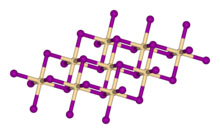Calcium iodide
 | |
| Names | |
|---|---|
| IUPAC name
calcium iodide | |
| Identifiers | |
| 10102-68-8 13640-62-5 (tetrahydrate) | |
| 3D model (Jmol) | Interactive image |
| ChemSpider | 59629 |
| ECHA InfoCard | 100.030.238 |
| PubChem | 66244 |
| RTECS number | EV1300000 |
| UNII | 8EKI9QEE2H |
| |
| |
| Properties | |
| CaI2 | |
| Molar mass | 293.887 g/mol (anhydrous) 365.95 g/mol (tetrahydrate) |
| Appearance | white solid |
| Density | 3.956 g/cm3 (anhydrous)[1] |
| Melting point | 779 °C (1,434 °F; 1,052 K) (anhydrous) [2] |
| Boiling point | 1,100 °C (2,010 °F; 1,370 K) [2] |
| 64.6 g/100 mL (0 °C) 66 g/100 mL (20 °C) 81 g/100 mL (100 °C) | |
| Solubility | soluble in acetone and alcohols |
| Structure | |
| Rhombohedral, hP3 | |
| P-3m1, No. 164 | |
| octahedral | |
| Hazards | |
| NFPA 704 | |
| Related compounds | |
| Other anions |
calcium fluoride calcium chloride calcium bromide |
| Other cations |
beryllium iodide magnesium iodide strontium iodide barium iodide |
| Except where otherwise noted, data are given for materials in their standard state (at 25 °C [77 °F], 100 kPa). | |
| | |
| Infobox references | |
Calcium iodide (chemical formula CaI2) is the ionic compound of calcium and iodine. This colourless deliquescent solid is a salt that is highly soluble in water. Its properties are similar to those for related salts, such as calcium chloride. It is used in photography.[1] It is also used in cat food as a source of iodine.
Reactions
Henri Moissan first isolated pure calcium in 1898 by reducing calcium iodide with pure sodium metal:[3]
Calcium iodide can be formed by treating calcium carbonate, calcium oxide, or calcium hydroxide with hydroiodic acid:[4]
Calcium iodide slowly reacts with oxygen and carbon dioxide in the air, liberating iodine, which is responsible for the faint yellow color of impure samples.[5]
- 2 CaI2 + 2 CO2 + O2 → 2 CaCO3 + 2 I2
References
- 1 2 Turner, Jr., Francis M., ed. (1920), The Condensed Chemical Dictionary (1st ed.), New York: Chemical Catalog Co., p. 127, retrieved 2007-12-08
- 1 2 R. J. Lewis (1993), Hawley's Condensed Chemical Dictionary 12th edition
- ↑ Mellor, Joseph William (1912), Modern Inorganic Chemistry, New York: Longmans, Green, and Co, p. 334, 6909989325689, retrieved 2007-12-08
- ↑ Gooch, Frank Austin; Walker, Claude Frederic (1905), Outlines of Inorganic Chemistry, New York: Macmillan, p. 340, retrieved 2007-12-08
- ↑ Jones, Harry Clary (1906), Principles of Inorganic Chemistry, New York: Macmillan, p. 365, retrieved 2007-12-08
This article is issued from Wikipedia - version of the 11/10/2016. The text is available under the Creative Commons Attribution/Share Alike but additional terms may apply for the media files.
